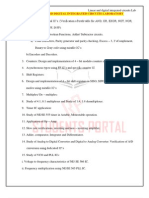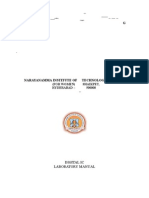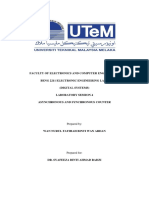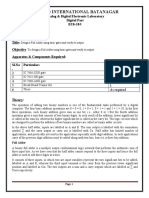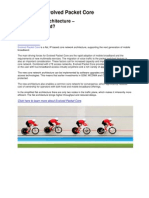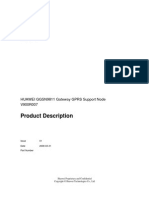LD Lab Manual 2
LD Lab Manual 2
Uploaded by
Rishi BhatnagarCopyright:
Available Formats
LD Lab Manual 2
LD Lab Manual 2
Uploaded by
Rishi BhatnagarOriginal Title
Copyright
Available Formats
Share this document
Did you find this document useful?
Is this content inappropriate?
Copyright:
Available Formats
LD Lab Manual 2
LD Lab Manual 2
Uploaded by
Rishi BhatnagarCopyright:
Available Formats
DIGITAL ELECTRONICS LAB MANUAL
FOR IV SEMESTER B.E (ECE / EI)
DEPARTMENT OF ELECTRONICS & COMMUNICATION
NATIONAL INSTITUTE OF TECHNOLOGICAL, ROURKELA
1
CONTENTS
Experiment No
Page. No
1. VERIFICATIONOFGATES03 2. HALFADDER/FULLADDER/SUBTRACTOR08 3. Multiplexer and demultiplexer
4. COMPARATORS 5. FLIPFLOP 6. COUNTERS 7. SHIFTREGISTERS
EXPERIMENT 1
VERIFICATION OF GATES
Inverter Gate (NOT Gate)
7404LS
2-input AND gate
7408LS
2-input OR gate
7432LS
2-input NAND gate
4
7400LS
2-input NOR gate
7402LS
2-input EX-OR gate
7486LS
3-input NAND gate
7410LS
2-input NAND gate
CD4011
2-input NOR gate
CD4001
4-input NAND gate
7420LS
Experiment 2
Half/full adder & Half/full subtractor
7
Aim: - To realize half/full adder and half/full subtractor. i. ii. Using X-OR and basic gates Using only NAND gates.
Apparatus Required: IC 7486, IC 7432, IC 7408, IC 7400, etc.
Procedure: 1. Verify the gates. 2. Make the connections as per the circuit diagram. 3. Switch on V CC and apply various combinations of input according to the truth table 4. Note down the output readings for half/full adder and half/full subtractor sum/difference and the carry/borrow bit for different combination of input.
Half Adder using basic gates:8
Full Adder using basic gates:-
Half Adder using NAND gates only:-
Full adder using NAND gates only:9
1)
Using X-OR and basic gates (a) Half subtractor
(b) Full subtractor
2)
Using only NAND gates
10
(a)Half subtractor
(b)
Full subtractor
11
12
Experiment :-3
Multiplexer And Demultiplexer
Aim: - To verify the truth table of multiplexer using 74153 & to verify a demultiplexer using 74139. To study the arithmetic circuits half-adder half Subtractor, full adder and full Subtractor using multiplexer. Apparatus Required: IC 74153, IC 74139, IC 7404, etc. Procedure: - (IC 74153) 1. The Pin [16] is connected to + Vcc. 2. Pin [8] is connected to ground. 3. The inputs are applied either to A input or B input 4. If MUX A has to be initialized, Ea is made low and if MUX B has to be initialized, E is made low. 5. Based on the selection lines one of the inputs will be selected at the output and thus the truth table is verified. 6. In case of half adder using MUX, sum and carry is obtained by applying a constant inputs at I0a, I1a,I2a,I3a and I0b,I1b,I2b and I3b and the corresponding values of select lines are changed as per table and the output is taken at Z0a as sum and Z0b as carry. 7. In this case, the channels A and B are kept at constant inputs according to the table and the inputs A and B are varied. Making Ea and Eb zero and the output is taken at Za, and Zb. 8. In full adder using MUX, the input is applied at Cn-1, An and Bn According to the table corresponding outputs are taken at Cn and Dn.
13
Half Adder using 74153:-
Full Adder using 74153:-
Half Substractor :-
Full Substractor:-
14
Pin Details:
15
Procedure: - (IC 74139) 1. The inputs are applied to either a input or b input 2. The demux is activated by making Ea low and Eb low. 3. The truth table is verified
16
Experiment no:-4
COMPARATORS
Aim: - To verify the truth table of one bit and two bit comparators using logic gates. Apparatus Required: IC 7486, IC 7404, IC 7408, etc Procedure: 1. Verify the gates. 2. Make the connections as per the circuit diagram. 3. Switch on Vcc. 4. Applying I/p and Check for the outputs. 5. The voltmeter readings of outputs are taken and tabulated in tabular column. 6. The o/p is verified.
One bit comparator
17
Two bit comparator
4-bit comparator
18
8-bit comparator
Tabular column for 8-bit comparator
19
Experiment no:-5
FLIP-FLOP
Aim: - Truth table verification of Flip-Flops: 1) JK Master Slave 2) D- Type 3) T- Type Apparatus Required: IC 7410, IC 7400, etc. Procedure: 1. Connections are made as per circuit diagram. 2. The truth table is verified for various combinations of inputs Circuit Diagram: -
Master Slave JK Flip-Flop
20
D Flip-Flop
T Flip-Flop
21
Truth Table:-
Master Slave JK Flip-Flop
D Flip-Flop
T Flip-Flop
22
Experiment no: - 6
COUNTERS
Aim:- Realization of 3-bit counters as a sequential circuit and Mod-N counter design (7476, 7490, 74192, 74193). Apparatus Required:IC 7408, IC 7476, IC 7490, IC 74192, IC 74193, IC 7400, IC 7416, IC 7432 etc. Procedure: 1. Connections are made as per circuit diagram. 2. Clock pulses are applied one by one at the clock I/P and the O/P is observed at QA, QB & QC for IC 7476. 3. Truth table is verified. Procedure (IC 74192, IC 74193):1. Connections are made as per the circuit diagram except the connection from output of NAND gate to the load input 2. The data (0011) = 3 is made available at the data i/ps A, B, C & D respectively. 3. The load pin made low so that the data 0011 appears at QD, QC, QB & QA respectively. 4. Now connect the output of the NAND gate to the load input 5. Clock pulses are applied to count up pin and the truth table is verified 6. Now apply (1100) = 12 for 12 to 5 counter and remaining is same as for 3 to 8 counter. 7. The pin diagram of IC 74192 is same as that of 74193. 74192 can be configured to count between 0 and 9 in either direction. The starting value can be any number between 0 and 9
23
Circuit Diagram: - 3-Bit Asynchronous Down Counter
Mod 5 Asynchronous Counter:-
24
Mod 3 Asynchronous Counter:-
25
3-bit Synchronous Counter:-
IC 7490 (Decade Counter):-
26
IC 7490 (MOD-8 Counter):-
Circuit Diagram (IC 74193) To Count from 3 to 8:-
Circuit Diagram (IC 74193) To Count from 8 to 3:-
27
Function Table for 7490:-
4 I/P OR Gate can be realized as follows:-
28
Experiment:-7 SHIFT REGISTERS
Aim: - Realization of 3-bit counters as a sequential circuit and Mod-N counter design (7476, 7490, 74192, 74193). Apparatus Required: IC 7495, etc. Procedure: Serial In Parallel Out:1. Connections are made as per circuit diagram. 2. Apply the data at serial i/p 3. Apply one clock pulse at clock 1 (Right Shift) observe this data at QA. 4. Apply the next data at serial i/p. 5. Apply one clock pulse at clock 2, observe that the data on QA will shift to QB and the new data applied will appear at QA. 6. Repeat steps 2 and 3 till all the 4 bits data are entered one by one into the shift register. Pin diagram: Truth Table:-
29
Serial In Serial Out:1. Connections are made as per circuit diagram. 2. Load the shift register with 4 bits of data one by one serially. 3. At the end of 4th clock pulse the first data d0 appears at QD. 4. Apply another clock pulse; the second data d1 appears at QD. 5. Apply another clock pulse; the third data appears at QD. 6. Application of next clock pulse will enable the 4th data d3 to appear at QD. Thus the data applied serially at the input comes out serially at QD
Pin Diagram:
Truth Table:-
Parallel In Parallel Out:1. Connections are made as per circuit diagram. 2. Apply the 4 bit data at A, B, C and D. 3. Apply one clock pulse at Clock 2 (Note: Mode control M=1). 4. The 4 bit data at A, B, C and D appears at QA, QB, QC and QD respectively.
30
Truth Table:-
Parallel In Serial Out:1. Connections are made as per circuit diagram. 2. Apply the desired 4 bit data at A, B, C and D. 3. Keeping the mode control M=1 apply one clock pulse. The data applied at A, B, C and D will appear at QA, QB, QC and QD respectively. 4. Now mode control M=0. Apply clock pulses one by one and observe the data coming out serially at QD.
31
Truth Table:-
32
Left Shift:1. Connections are made as per circuit diagram 2. Apply the first data at D and apply one clock pulse. This data appears at QD. 3. Now the second data is made available at D and one clock pulse applied. The data appears at QD to QC and the new data appears at QD. 4. Step 3 is repeated until all the 4 bits are entered one by one At the end 4th clock pulse the 4 bits are available at QA, QB, QC and QD.
Pin diagram: -
Truth Table:-
Conclusion :
33
You might also like
- De Lab ManualDocument20 pagesDe Lab ManualVishesh ShrivastavaNo ratings yet
- SapnaDocument17 pagesSapnaHarshit UpadhyayNo ratings yet
- EXP 6 Serial AdderDocument2 pagesEXP 6 Serial Adderubuntu 13.0450% (2)
- DCLD LabDocument42 pagesDCLD LabRachit ChauhanNo ratings yet
- De Lab Manual-EEE New1Document77 pagesDe Lab Manual-EEE New1selva_raj215414No ratings yet
- Lab Manual - DEDocument41 pagesLab Manual - DEAnkur Giri100% (2)
- Syllabus: Department of Computer Science & Engineering Lab Manual Digital Lab Class: 2 Yr, 3 SemDocument104 pagesSyllabus: Department of Computer Science & Engineering Lab Manual Digital Lab Class: 2 Yr, 3 SemPECMURUGANNo ratings yet
- Linear Integrated Circuits Lab ManualDocument74 pagesLinear Integrated Circuits Lab Manualarivurp100% (2)
- Digital Systems Lab ManualDocument63 pagesDigital Systems Lab Manualinfant199218No ratings yet
- Digital Lab CS2207 Lab ManualDocument41 pagesDigital Lab CS2207 Lab ManualSingh VelNo ratings yet
- Digital LabDocument64 pagesDigital LabPurush JayaramanNo ratings yet
- Digital LabDocument51 pagesDigital LabBala SubramanianNo ratings yet
- Lab ManualDocument24 pagesLab ManualJaferNo ratings yet
- Design of Half Full Adder, Half Full Subtractor and Parallel AddersubtractorDocument7 pagesDesign of Half Full Adder, Half Full Subtractor and Parallel AddersubtractorMani Bharathi100% (1)
- Traffic LightDocument19 pagesTraffic LightDianne ParNo ratings yet
- Co Lab ManualDocument22 pagesCo Lab ManualSachin Saxena100% (2)
- DLD Lab ManualDocument35 pagesDLD Lab ManualHrishikesh Garud100% (2)
- Ec2207 - Digital Electronics Lab ManualDocument83 pagesEc2207 - Digital Electronics Lab ManualasrafalisNo ratings yet
- Digital Electronics Lab ManualDocument50 pagesDigital Electronics Lab Manualmohanbabu0% (1)
- Lab 9Document6 pagesLab 9XavosNo ratings yet
- De Lab ManualDocument22 pagesDe Lab ManualAniruth KowshikNo ratings yet
- EE6311-Linear and Digital Integrated Circuits LaboratoryDocument97 pagesEE6311-Linear and Digital Integrated Circuits LaboratoryGNo ratings yet
- Lab Report 1 EE32200 - Ronny VintimillaDocument16 pagesLab Report 1 EE32200 - Ronny VintimillaRonny VintimillaNo ratings yet
- Digital Electronics Lab ManualDocument57 pagesDigital Electronics Lab ManualComputer Sc & BCA DepartmentNo ratings yet
- Lic ManualDocument80 pagesLic ManualSureshKumarNo ratings yet
- Cs2207 LMDocument66 pagesCs2207 LMShan MugamNo ratings yet
- De Lab ManualDocument95 pagesDe Lab ManualarunkumarNo ratings yet
- Exp 9Document4 pagesExp 9vbbdbd71No ratings yet
- De Lab ManualDocument53 pagesDe Lab ManualgopiikrishnaNo ratings yet
- Practical DTDocument19 pagesPractical DTKundan BhartiNo ratings yet
- Digital Lab ManualDocument77 pagesDigital Lab ManualSaravanan JaganNo ratings yet
- De Lab PDFDocument36 pagesDe Lab PDFPadmasri GirirajanNo ratings yet
- Dlcoa All Exp 24-25 (1)Document55 pagesDlcoa All Exp 24-25 (1)ayush.231233106No ratings yet
- EC2207 - Digital Electronics LAB MannualDocument102 pagesEC2207 - Digital Electronics LAB MannualSathiya RajNo ratings yet
- 21425-9021-Digital Electronics Lab ManualDocument57 pages21425-9021-Digital Electronics Lab ManualAravind BalasundaramNo ratings yet
- LOGSWCH Lab1Document3 pagesLOGSWCH Lab1topherski100% (1)
- Co Lab Manual IIDocument48 pagesCo Lab Manual IITanvi JainNo ratings yet
- Laboratory Manual Course Code:Ece 201Document41 pagesLaboratory Manual Course Code:Ece 201Er Sacchu SrivastavaNo ratings yet
- DSD Lab Manual AitdDocument31 pagesDSD Lab Manual Aitdprathameshbhat88No ratings yet
- Asynchronous and Synchronous CounterDocument10 pagesAsynchronous and Synchronous CounterNurul Fatihah ArdanNo ratings yet
- EXP 10-11 MergedDocument20 pagesEXP 10-11 MergedNitesh KumarNo ratings yet
- Dpco Lab ManualDocument55 pagesDpco Lab ManualBELMER GLADSON Asst. Prof. (CSE)No ratings yet
- CS3351 - DIGITAL PRINCIPLES AND COMPUTER ORGANIZATION LaboratoryDocument64 pagesCS3351 - DIGITAL PRINCIPLES AND COMPUTER ORGANIZATION Laboratoryparanjothi karthikNo ratings yet
- ADEC LabDocument16 pagesADEC LabPraveen TPNo ratings yet
- DTE IMP (1)Document11 pagesDTE IMP (1)mrscollege235No ratings yet
- Experiment No 1 - Full AdderDocument4 pagesExperiment No 1 - Full AdderVikyNo ratings yet
- 17 - de Exp Journal - EcsDocument48 pages17 - de Exp Journal - EcsPrakalp JhaNo ratings yet
- Digital Lab Manual EC1010Document68 pagesDigital Lab Manual EC1010Suhaib KhanNo ratings yet
- Experiment 4 - LabDocument7 pagesExperiment 4 - LabwanieNo ratings yet
- Experiment 5Document5 pagesExperiment 5rutujakjadhav20No ratings yet
- Kunalppt 1Document11 pagesKunalppt 1kisevit591No ratings yet
- Design of Electrical Circuits using Engineering Software ToolsFrom EverandDesign of Electrical Circuits using Engineering Software ToolsNo ratings yet
- Reference Guide To Useful Electronic Circuits And Circuit Design Techniques - Part 2From EverandReference Guide To Useful Electronic Circuits And Circuit Design Techniques - Part 2No ratings yet
- Reference Guide To Useful Electronic Circuits And Circuit Design Techniques - Part 1From EverandReference Guide To Useful Electronic Circuits And Circuit Design Techniques - Part 1Rating: 2.5 out of 5 stars2.5/5 (3)
- Arduino Measurements in Science: Advanced Techniques and Data ProjectsFrom EverandArduino Measurements in Science: Advanced Techniques and Data ProjectsNo ratings yet
- Digital Electronics 2: Sequential and Arithmetic Logic CircuitsFrom EverandDigital Electronics 2: Sequential and Arithmetic Logic CircuitsRating: 5 out of 5 stars5/5 (1)
- Exploring BeagleBone: Tools and Techniques for Building with Embedded LinuxFrom EverandExploring BeagleBone: Tools and Techniques for Building with Embedded LinuxRating: 4 out of 5 stars4/5 (2)
- Electrical Distribution System of a Skyscraper in the United StatesFrom EverandElectrical Distribution System of a Skyscraper in the United StatesNo ratings yet
- 100G OTN Transponder: Cost-Efficient Transport of 100G in Metro NetworksDocument2 pages100G OTN Transponder: Cost-Efficient Transport of 100G in Metro NetworkshasNo ratings yet
- SatelliteDocument3 pagesSatellitepavanNo ratings yet
- Computer PYQ ExplanationDocument28 pagesComputer PYQ ExplanationNitin PatilNo ratings yet
- Lesson 1Document83 pagesLesson 1darlene jane maynes50% (4)
- ABAP Programming (BC-ABA)Document344 pagesABAP Programming (BC-ABA)ksagar10No ratings yet
- Q1: What Are The Fundamental Characteristics On Which The Effectiveness of Data Communication Depends On?Document7 pagesQ1: What Are The Fundamental Characteristics On Which The Effectiveness of Data Communication Depends On?Anzar AftabNo ratings yet
- TouchAble 3 InappguideDocument1 pageTouchAble 3 Inappguideandrewpiano100% (1)
- OEM12C Management Pack For EBS PDFDocument338 pagesOEM12C Management Pack For EBS PDFPankaj GuptaNo ratings yet
- EpcDocument3 pagesEpcRobinChenNo ratings yet
- Image Processing and Computer Vision: GoalsDocument14 pagesImage Processing and Computer Vision: Goalsكرميلا عليNo ratings yet
- MB Guide PDFDocument80 pagesMB Guide PDFAko Cee JayNo ratings yet
- Grid Architecture and Relationship To Other Distributed TechnologiesDocument24 pagesGrid Architecture and Relationship To Other Distributed TechnologiesWaqarAhmadAlvi67% (3)
- Mobile Operating System: Analysis and Comparison of Android and iOSDocument4 pagesMobile Operating System: Analysis and Comparison of Android and iOSobaid ur rehmanNo ratings yet
- CAB-2 (Chapter 16)Document19 pagesCAB-2 (Chapter 16)koonjNo ratings yet
- Hyperion EPM 11.1.2.4 Installation GuideDocument66 pagesHyperion EPM 11.1.2.4 Installation GuideCharlito Mikolli100% (1)
- 2-GGSN9811 V900R007 Product DescriptionDocument91 pages2-GGSN9811 V900R007 Product DescriptionPeyman Allahverdian100% (3)
- NSM Ds Web PDFDocument12 pagesNSM Ds Web PDFcelNo ratings yet
- What Is Inter What Is Internet Speed?: What Does "Download Speed" Actually Mean? "Download Speed" Actually Mean?Document6 pagesWhat Is Inter What Is Internet Speed?: What Does "Download Speed" Actually Mean? "Download Speed" Actually Mean?Neeraj RaikwarNo ratings yet
- SM - x551 - GACMA0 - ENG (Courier Protocol) PDFDocument96 pagesSM - x551 - GACMA0 - ENG (Courier Protocol) PDFJessada SatwinitNo ratings yet
- Introduction To Model-View-Controller (MVC) Web Programming With TurbogearsDocument19 pagesIntroduction To Model-View-Controller (MVC) Web Programming With TurbogearsHafssaIdelaameurNo ratings yet
- Passing Multiple Parameters in SSRSDocument2 pagesPassing Multiple Parameters in SSRSVidya SagarNo ratings yet
- MotionDriver Tutorial 12212018 CBDocument12 pagesMotionDriver Tutorial 12212018 CBDamianNo ratings yet
- Android DisklessDocument4 pagesAndroid DisklessVivek ParmarNo ratings yet
- Lista1 2009 01Document4 pagesLista1 2009 01AstrolopetecsNo ratings yet
- International Journal of Computer (IJC) (ISSN 2307-4523) Volume 8 No1 2012Document3 pagesInternational Journal of Computer (IJC) (ISSN 2307-4523) Volume 8 No1 2012International Journal of Computer (IJC)No ratings yet
- C Programming Bangla Book PDF C Programming Bangla Book PDFDocument2 pagesC Programming Bangla Book PDF C Programming Bangla Book PDFA Rahaman100% (1)
- Dcs-932l Reva Releasenotes 1.10.03 en UsDocument4 pagesDcs-932l Reva Releasenotes 1.10.03 en Usarrw666No ratings yet
- EeproDocument4 pagesEeproAnkit DhimanNo ratings yet
- General Manual V1 Viper S PDFDocument122 pagesGeneral Manual V1 Viper S PDFIulian AntoheNo ratings yet
- Windows Security Settings Working AideDocument81 pagesWindows Security Settings Working Aideapi-3747124100% (5)







